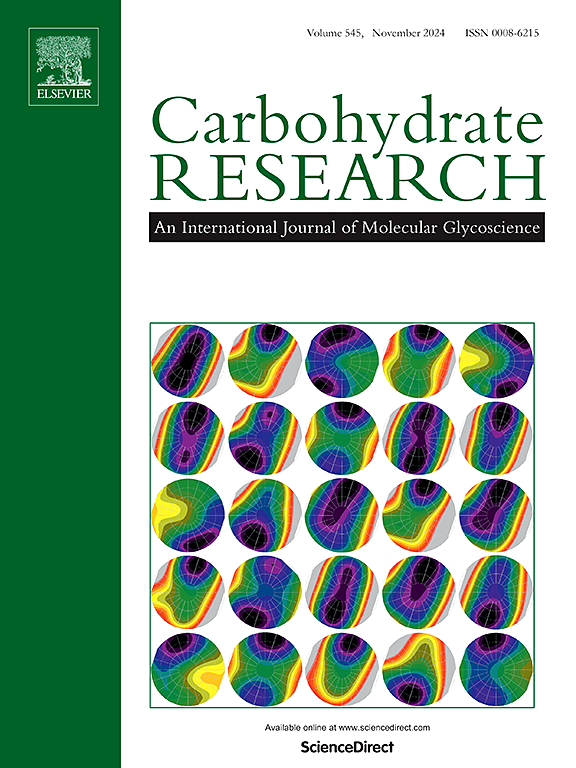Preparation and characterization of polysaccharide-derived smart nanocarriers for stimuli-responsive delivery of natural extracts in NSCLC therapy
IF 2.5
3区 化学
Q3 BIOCHEMISTRY & MOLECULAR BIOLOGY
引用次数: 0
Abstract
Non-small cell lung cancer (NSCLC) has a poor prognosis due to late diagnosis and high metastasis, while existing agents like Cucurbitaceae-derived Compound 1 are limited by low solubility, poor targeting, and high normal cell toxicity. This study aimed to construct a fluorinated hyaluronic acid nanocarrier (HA-2@1) to load Compound 1, improving its solubility/biocompatibility, enabling NSCLC-targeted delivery, and enhancing therapeutic efficacy. In vitro experiments included pH-responsive drug release testing, fluorescence spectroscopy for carrier-drug interactions, and CCK-8 cytotoxicity assays on A549 (NSCLC) and BEAS-2B (normal lung) cells, compared with free Compound 1. Results showed: HA-2@1 released 75 % of Compound 1 at pH 5.0 (tumor microenvironment) vs. 43 % at pH 7.4 (physiological condition) within 120 h; Compound 1 loading reduced HA-2 fluorescence by 26 % (intermolecular quenching) with further aggregation-driven quenching at 100 μg/mL; HA-2@1 decreased A549 viability by 25 % at 48 h, and its toxicity to BEAS-2B cells (7 % at 200 μg/mL) was far lower than free Compound 1 (53 %). In conclusion, HA-2@1 offers targeted delivery, fluorescence tracking, low toxicity, and efficient release, providing a promising nano-strategy for NSCLC therapy and a reference for natural product carrier optimization.

用于非小细胞肺癌治疗中天然提取物刺激反应递送的多糖衍生智能纳米载体的制备和表征。
非小细胞肺癌(NSCLC)由于诊断晚、转移率高,预后较差,而现有的葫芦科衍生化合物1等药物溶解度低、靶向性差、正常细胞毒性高。本研究旨在构建含氟透明质酸纳米载体(HA-2@1)来装载化合物1,提高其溶解度/生物相容性,实现nsclc靶向递送,提高治疗效果。体外实验包括ph响应性药物释放测试、载体-药物相互作用的荧光光谱分析、对A549 (NSCLC)和BEAS-2B(正常肺)细胞的CCK-8细胞毒性测定,并与游离化合物1进行比较。结果表明:HA-2@1在pH 5.0(肿瘤微环境)条件下,120 h内化合物1的释放率为75%,生理条件下为43%;化合物1负载使HA-2荧光降低26%(分子间猝灭),并在100 μg/mL时进一步聚集驱动猝灭;HA-2@1作用48 h使A549细胞活力降低25%,对BEAS-2B细胞的毒性(200 μg/mL为7%)远低于游离化合物1(53%)。总之,HA-2@1具有靶向递送、荧光跟踪、低毒性和高效释放的特点,为NSCLC治疗提供了一种有前景的纳米策略,也为天然产物载体优化提供了参考。
本文章由计算机程序翻译,如有差异,请以英文原文为准。
求助全文
约1分钟内获得全文
求助全文
来源期刊

Carbohydrate Research
化学-生化与分子生物学
CiteScore
5.00
自引率
3.20%
发文量
183
审稿时长
3.6 weeks
期刊介绍:
Carbohydrate Research publishes reports of original research in the following areas of carbohydrate science: action of enzymes, analytical chemistry, biochemistry (biosynthesis, degradation, structural and functional biochemistry, conformation, molecular recognition, enzyme mechanisms, carbohydrate-processing enzymes, including glycosidases and glycosyltransferases), chemical synthesis, isolation of natural products, physicochemical studies, reactions and their mechanisms, the study of structures and stereochemistry, and technological aspects.
Papers on polysaccharides should have a "molecular" component; that is a paper on new or modified polysaccharides should include structural information and characterization in addition to the usual studies of rheological properties and the like. A paper on a new, naturally occurring polysaccharide should include structural information, defining monosaccharide components and linkage sequence.
Papers devoted wholly or partly to X-ray crystallographic studies, or to computational aspects (molecular mechanics or molecular orbital calculations, simulations via molecular dynamics), will be considered if they meet certain criteria. For computational papers the requirements are that the methods used be specified in sufficient detail to permit replication of the results, and that the conclusions be shown to have relevance to experimental observations - the authors'' own data or data from the literature. Specific directions for the presentation of X-ray data are given below under Results and "discussion".
 求助内容:
求助内容: 应助结果提醒方式:
应助结果提醒方式:


